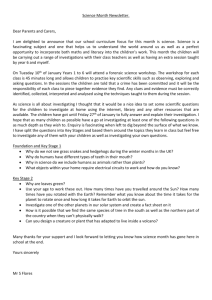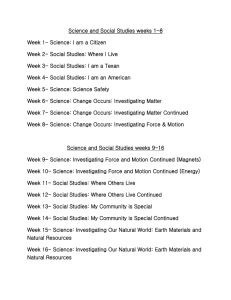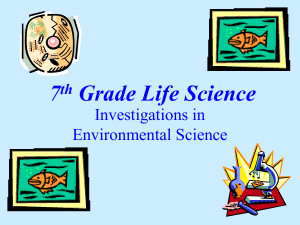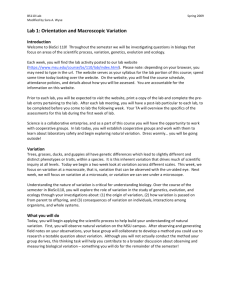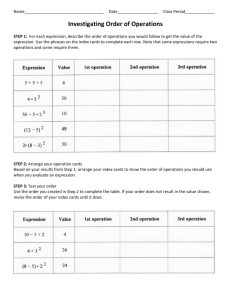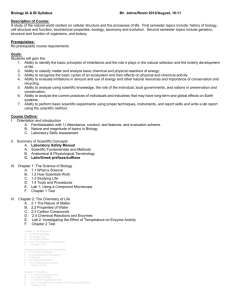Biology, Miller & Levine (Dragonfly) Illustrated Guide to Home
advertisement
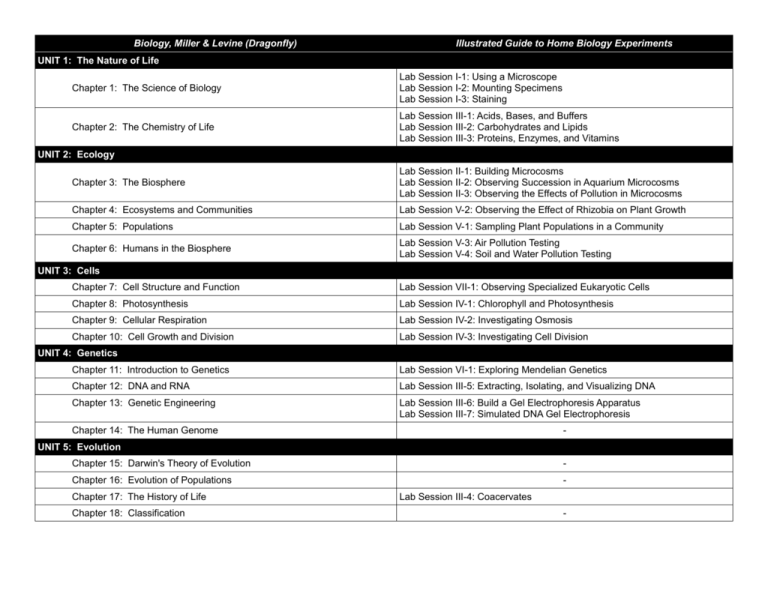
Biology, Miller & Levine (Dragonfly) Illustrated Guide to Home Biology Experiments UNIT 1: The Nature of Life Chapter 1: The Science of Biology Lab Session I-1: Using a Microscope Lab Session I-2: Mounting Specimens Lab Session I-3: Staining Chapter 2: The Chemistry of Life Lab Session III-1: Acids, Bases, and Buffers Lab Session III-2: Carbohydrates and Lipids Lab Session III-3: Proteins, Enzymes, and Vitamins UNIT 2: Ecology Chapter 3: The Biosphere Lab Session II-1: Building Microcosms Lab Session II-2: Observing Succession in Aquarium Microcosms Lab Session II-3: Observing the Effects of Pollution in Microcosms Chapter 4: Ecosystems and Communities Lab Session V-2: Observing the Effect of Rhizobia on Plant Growth Chapter 5: Populations Lab Session V-1: Sampling Plant Populations in a Community Chapter 6: Humans in the Biosphere Lab Session V-3: Air Pollution Testing Lab Session V-4: Soil and Water Pollution Testing UNIT 3: Cells Chapter 7: Cell Structure and Function Lab Session VII-1: Observing Specialized Eukaryotic Cells Chapter 8: Photosynthesis Lab Session IV-1: Chlorophyll and Photosynthesis Chapter 9: Cellular Respiration Lab Session IV-2: Investigating Osmosis Chapter 10: Cell Growth and Division Lab Session IV-3: Investigating Cell Division UNIT 4: Genetics Chapter 11: Introduction to Genetics Lab Session VI-1: Exploring Mendelian Genetics Chapter 12: DNA and RNA Lab Session III-5: Extracting, Isolating, and Visualizing DNA Chapter 13: Genetic Engineering Lab Session III-6: Build a Gel Electrophoresis Apparatus Lab Session III-7: Simulated DNA Gel Electrophoresis Chapter 14: The Human Genome - UNIT 5: Evolution Chapter 15: Darwin's Theory of Evolution - Chapter 16: Evolution of Populations - Chapter 17: The History of Life Chapter 18: Classification Lab Session III-4: Coacervates - UNIT 6: Microorganisms and Fungi Chapter 19: Bacteria and Viruses Lab Session VII-2: Preparing Culturing Media Lab Session VII-3: Culturing Bacteria Lab Session VII-4: Investigating Bacterial Antibiotic Sensitivity Chapter 20: Protists Lab Session VIII-1: Investigating Protista Chapter 21: Fungi Lab Session IX-1: Investigating Fungi UNIT 7: Plants Chapter 22: Plant Diversity Lab Session X-1: Investigating Simple Plants: Mosses and Ferns Chapter 23: Roots, Stems, and Leaves Chapter 24: Reproduction of Seed Plants Lab Session X-2: Investigating Seed Plants Chapter 25: Plant Responses and Adaptations UNIT 8: Invertebrates Chapter 26: Sponges and Cnidarians Lab Session XI-1: Investigating Porifera and Cnidaria Chapter 27: Worms and Mollusks Lab Session XI-2: Investigating Platyhelminthes, Nematoda, and Annelida Chapter 28: Arthropods and Echinoderms Lab Session XI-3: Investigating Arthropods Chapter 29: Comparing Invertebrates (invertebrates are compared in the other three sessions in this group) UNIT 9: Chordates Chapter 30: Nonvertebrate Chordates, Fishes, and Amphibians Chapter 31: Reptiles and Birds Chapter 32: Mammals Lab Session XI-4: Investigating Vertebrate Tissues Chapter 33: Comparing Chordates Chapter 34: Animal Behavior - UNIT 10: The Human Body Chapter 35: Nervous System Chapter 36: Skeletal, Muscular, and Integumentary Systems Chapter 37: Circulatory and Respiratory Systems Chapter 38: Digestive and Excretory Systems Chapter 39: Endocrine and Reproductive Systems Chapter 40: The Immune System and Disease (These systems are examined at the cellular and tissue level in Lab Session XI-4: Investigating Vertebrate Tissues)


